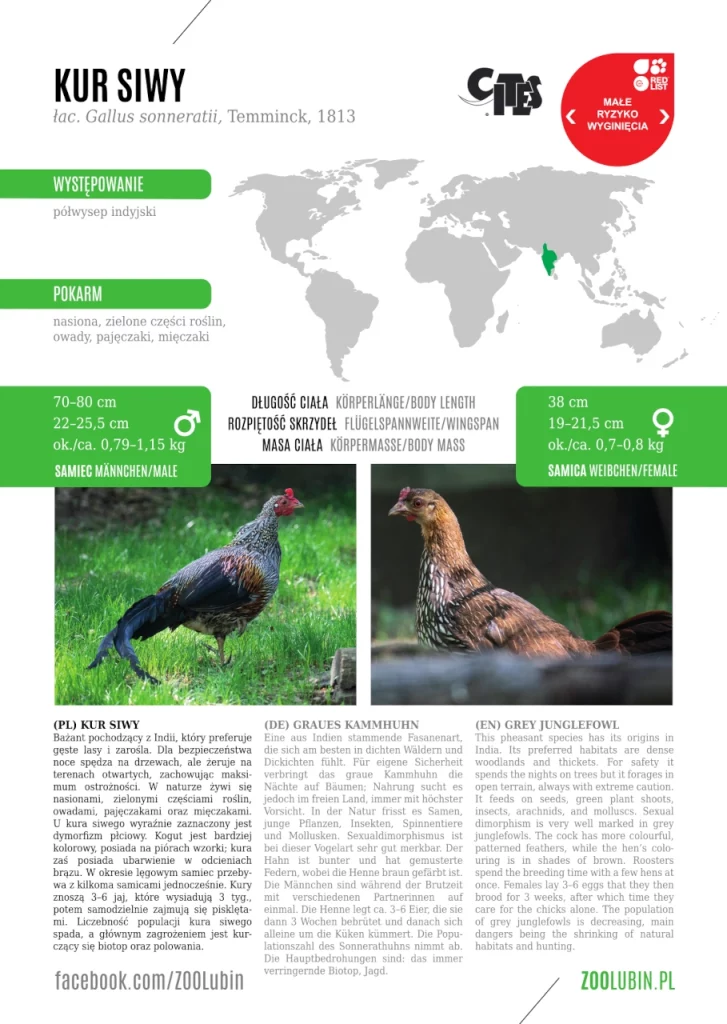
POBIERZ ETYKIETĘ GATUNKOWĄ – PLIK PDF (rozmiar 2548 KB)
Kur siwy (PL)
łac. Gallus sonneratii, Temminck, 1813
Bażant pochodzący z Indii, który preferuje gęste lasy i zarośla. Dla bezpieczeństwa noce spędza na drzewach, ale żeruje na terenach otwartych, zachowując maksimum ostrożności. W naturze żywi się nasionami, zielonymi częściami roślin, owadami, pajęczakami oraz mięczakami. U kura siwego wyraźnie zaznaczony jest dymorfizm płciowy. Kogut jest bardziej kolorowy, posiada na piórach wzorki; kura zaś posiada ubarwienie w odcieniach brązu. W okresie lęgowym samiec przebywa z kilkoma samicami jednocześnie. Kury znoszą 3–6 jaj, które wysiadują 3 tyg., potem samodzielnie zajmują się pisklętami. Liczebność populacji kura siwego spada, a głównym zagrożeniem jest kurczący się biotop oraz polowania.
Występowanie: Półwysep Indyjski
samiec
Długość ciała: 70–80 cm
Długość skrzydła: 22–25,5 cm
Masa ciała: ok. 0,79–1,15 kg
samica
Długość ciała: 38 cm
Długość skrzydła: 19–21,5 cm
Masa ciała: ok. 0,7–0,8 kg
Graues Kammhuhn (DE)
łac. Gallus sonneratii, Temminck, 1813
Eine aus Indien stammende Fasanenart, die sich am besten in dichten Wäldern und Dickichten fühlt. Für eigene Sicherheit verbringt das graue Kammhuhn die Nächte auf Bäumen; Nahrung sucht es jedoch im freien Land, immer mit höchster Vorsicht. In der Natur frisst es Samen, junge Pflanzen, Insekten, Spinnentiere und Mollusken. Sexualdimorphismus ist bei dieser Vogelart sehr gut merkbar. Der Hahn ist bunter und hat gemusterte Federn, wobei die Henne braun gefärbt ist. Die Männchen sind während der Brutzeit mit verschiedenen Partnerinnen auf einmal. Die Henne legt ca. 3–6 Eier, die sie dann 3 Wochen bebrütet und danach sich alleine um die Küken kümmert. Die Populationszahl des Sonnerathuhns nimmt ab. Die Hauptbedrohungen sind: das immer verringernde Biotop, Jagd.
Vorkommen: Indischer Subkontinent
Männchen
Körperlänge: 70–80 cm
Flügellänge: 22–25,5 cm
Körpermasse: ca. 0,79–1,15 kg
Weibchen
Körperlänge: 38 cm
Flügellänge: 19–21,5 cm
Körpermasse: ca. 0,7–0,8 kg
Grey junglefowl (EN)
łac. Gallus sonneratii, Temminck, 1813
This pheasant species has its origins in India. Its preferred habitats are dense woodlands and thickets. For safety it spends the nights on trees but it forages in open terrain, always with extreme caution. It feeds on seeds, green plant shoots, insects, arachnids, and molluscs. Sexual dimorphism is very well marked in grey junglefowls. The cock has more colourful, patterned feathers, while the hen’s colouring is in shades of brown. Roosters spend the breeding time with a few hens at once. Females lay 3–6 eggs that they then brood for 3 weeks, after which time they care for the chicks alone. The population of grey junglefowls is decreasing, main dangers being the shrinking of natural habitats and hunting.
Distribution: Indian subcontinent
male
body length: 70–80 cm
wing length: 22–25,5 cm
body mass: ca. 0,79–1,15 kg
female
body length: 38 cm
wing length: 19–21,5 cm
body mass: ca. 0,7–0,8 kg
